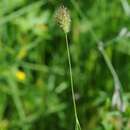en
names in breadcrumbs


Phleum (timothy) is a genus of annual and perennial plants in the grass family.[4] The genus is native to Europe, Asia and north Africa, with one species (P. alpinum) also in North and South America.[5]
They are tufted grasses growing to 20–150 cm tall, with cylindrical, spike-like panicles containing many densely packed spikelets.[6]
numerous species now considered better suited to other genera: Aegilops Alopecurus Beckmannia Crypsis Cynodon Cynosurus Digitaria Elytrophorus Ischaemum Mnesithea Muhlenbergia Pennisetum Pentameris Phalaris Polypogon Polytrias Sesleria Tribolium
Several species are important for cattle feed and as hay for horses and other domestic animals.[10]
Phleum (timothy) is a genus of annual and perennial plants in the grass family. The genus is native to Europe, Asia and north Africa, with one species (P. alpinum) also in North and South America.
They are tufted grasses growing to 20–150 cm tall, with cylindrical, spike-like panicles containing many densely packed spikelets.
Species Phleum alpinum – subarctic and mountainous areas in Eurasia, the Americas, South Georgia, etc. Phleum arenarium – western + southern Europe; Mediterranean Phleum bertolonii - Europe, Middle East Phleum boissieri - southwest Asia Phleum × brueggeri - France, Switzerland Phleum crypsoides - Sardinia, Greece, Cyprus Phleum echinatum - Italy, Greece, Balkans, Crimea Phleum exaratum - from Italy to Uzbekistan Phleum gibbum - Turkey Phleum himalaicum - Afghanistan, Pakistan, Kashmir Phleum hirsutum - central Europe, Balkans, Ukraine, Caucasus Phleum iranicum - Iran Phleum montanum - from Balkans to Iran Phleum paniculatum - from Spain to Japan Phleum phleoides – from Portugal + Morocco to eastern Siberia Phleum pratense – Timothy – from Portugal + Morocco to central Asia; naturalized in East Asia, the Americas, etc. Phleum subulatum - from Portugal to Pakistan Phleum × viniklarii - Dalmatia formerly includednumerous species now considered better suited to other genera: Aegilops Alopecurus Beckmannia Crypsis Cynodon Cynosurus Digitaria Elytrophorus Ischaemum Mnesithea Muhlenbergia Pennisetum Pentameris Phalaris Polypogon Polytrias Sesleria Tribolium